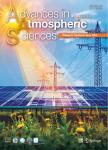On the Contrasting Decadal Changes of Diurnal Surface Temperature Range between the Tibetan Plateau and Southeastern China during the 1980s–2000s
On the Contrasting Decadal Changes of Diurnal Surface Temperature Range between the Tibetan Plateau and Southeastern China during the 1980s–2000s作者机构:State Key Laboratory of Numerical Modeling for Atmospheric Sciences and Geophysical Fluid Dynamics Institute of Atmospheric PhysicsChinese Academy of SciencesBeijing 100029China 1nstitute of Urban MeteorologyChina Meteorological AdministrationBeijing 100089China Collaborative Innovation Center on Forecast and Evaluation of Meteorological Disasters and KLMENanjing University of Information Science and TechnologyNanjing 210044China University of Chinese Academy of SciencesBeijing 100049China
出 版 物:《Advances in Atmospheric Sciences》 (大气科学进展(英文版))
年 卷 期:2017年第34卷第2期
页 面:181-198页
核心收录:
学科分类:07[理学] 070601[理学-气象学] 0706[理学-大气科学] 0816[工学-测绘科学与技术] 0825[工学-航空宇航科学与技术]
基 金:jointly supported by the China Meteorological Administration Special Public Welfare Research Fund(Grant No.GYHY201406001) the National Natural Science Foundation of China(Grant Nos.91437105,41575041 and 41430533) Special Foundation for National Commonweal Institutes of China(Grant No.IUMKY201614)
主 题:Tibetan Plateau diurnal surface temperature range decadal change CFRAM
摘 要:The diurnal surface temperature range (DTR) has become significantly smaller over the Tibetan Plateau (TP) but larger in southeastern China, despite the daily mean surface temperature having increased steadily in both areas during recent decades. Based on ERA-Interim reanalysis data covering 1979-2012, this study shows that the weakened DTR over TP is caused by stronger warming of daily minimum surface temperature (Tmin) and a weak cooling of the daily maximum surface temper- ature (Tmax); meanwhile, the enhanced DTR over southeastern China is mainly associated with a relatively stronger/weaker warming of Tmax/Tmin. A further quantitative analysis of DTR changes through a process-based decomposition method-- the Coupled Surface-Atmosphere Climate Feedback Response Analysis Method (CFRAM)--indicates that changes in radia- tive processes are mainly responsible for the decreased DTR over the TR In particular, the increased low-level cloud cover tends to induce the radiative cooling/warming during daytime/nighttime, and the increased water vapor helps to decrease the DTR through the stronger radiative wanning during nighttime than daytime. Contributions from the changes in all radiative processes (over -2℃) are compensated for by those from the stronger decreased surface sensible heat flux during daytime than during nighttime (approximately 2.5℃), but are co-contributed by the changes in atmospheric dynamics (approximately -0.4℃) and the stronger increased latent heat flux during daytime (approximately -0.8℃). In contrast, the increased DTR over southeastern China is mainly contributed by the changes in cloud, water vapor and atmospheric dynamics. The changes in surface heat fluxes have resulted in a decrease in DTR over southeastern China.



